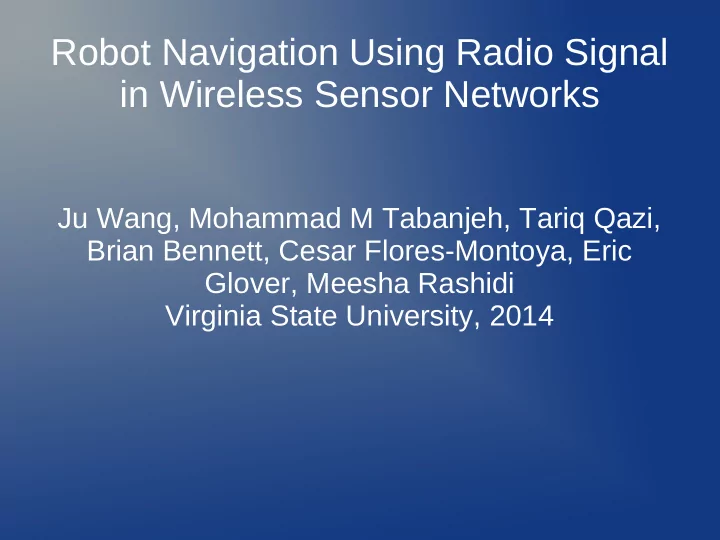

Robot Navigation Using Radio Signal in Wireless Sensor Networks Ju Wang, Mohammad M Tabanjeh, Tariq Qazi, Brian Bennett, Cesar Flores-Montoya, Eric Glover, Meesha Rashidi Virginia State University, 2014
Outline ● Background Robot RF localization ● RF Profile ● Distributed RF sensing ● Particle filtering ● Beacon set selection strategies ● Use of directional RSS measurements ● Test results
WSN Maintanence problem
RF based locating technique ● Radio Signal Strength is inversely proportional to the distance between T-R n RSS = C P s / D – ● RSS localization has been proven difficult to use due to – the high complex and nonlinear radio channelmodel in real deployments. ● RF sensing remains to be a low accuracy positioning tool ● For decent results, good (detail ) RF profile of the environment must be established
Indoor radio profiling ● Three wireless sensor nodes broadcast beacon packets ● ZigBee 0x0B (2405 MHz) ● Beacon packet contains a local SEQ # and a sensor node ID (unique) ● BEACON frequency programable (default 200 ms). ●
Indoor setting
Indoor RF profiles
Indoor RF profile data ● The RSS measurement result also shows a strong multi-path ● effect as the RSS is not monotonic of distance. ● strongest signal strength is in the range of 40 (- 51 dBm). ● The lowest RSSI observed is 12 (-79 dbm)
Maximum-Likelihood estimation P ri ● conditional probability for all observable beacon nodes. ● R: The active beacon set, defined by R = i : SS i >ζ ● ∂ ƛ∅ℵ ● ξ is the tolerance margin of radiosensor. ●
Beacon Set Selection ● Fixed one: one particular beacon node is fixed and not changed during the navigation course. ● Strongest RSS first: R only contain the beacon nodewith the highest RSS reading. ● Closest to Target first: here R will contain the beacon node that is closest to the target sensor. ● Highest gradient first: here R will contain the beacon node whose RSS at the estimated robot position is the steepest
Indoor location errors
OUTDOOR 2D NAVIGATION ● RF profile is established in a 2-D grid ● indirect matching: If the target node can’t be heard, the robot is guided by matching the RSS reading of the beacon nodes between the robot and the target node. ● The RSS measurement at the robot is denoted by SS = (ssr (θ1), ssr (θ2), ...ssr (θn)). ● Directional antenna Measurement angle: 270 degrees and the resolution is 270/4096 ●
Directional antenna profile
Navigation Algorithm ● Estimate the location of the target ● ● the location of the robot itself ● ● ● an optimum movement direction θ ∗ is calculated such that the RSS discrepency δSS will be reduced the most.
Results Navigation error ● Grid RF profile
Thanks for listening
Recommend
More recommend